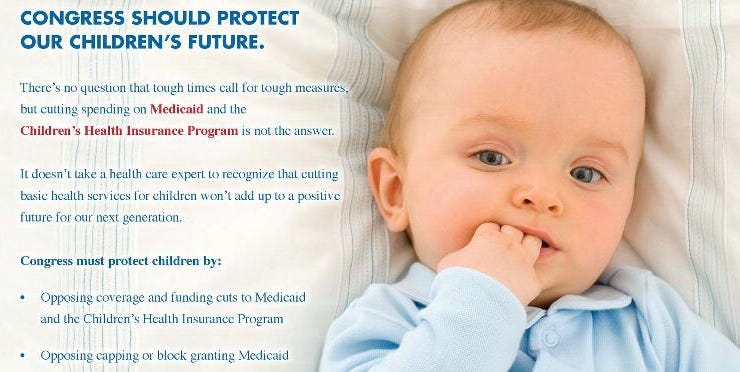A budget that puts America first would first and foremost invest in the next generation. Children should be a priority for investment and not a target for cuts.
Unfortunately, once again, the proposed budget by the Trump Administration is an disaster for children.
Although the President and Office of Management and Budget (OMB) Director Mick Mulvaney often like to pretend interest in investing in children by throwing kids a few scraps or head fakes by way of the President’s daughter Ivaka Trump, such as this year’s rather questionable child care proposal, the totality of what the Trump Administration is proposing targets kids for far more harm than good.

To ensure a bright and healthy future for our children, we should ensure their health coverage and well-being. Therefore, let’s begin with a look at health insurance coverage, including proposed changes to Medicaid, the Children’s Health Insurance Program (CHIP), and Affordable Care Act (ACA) marketplace coverage in the President’s budget.
Imposing Medicaid Block Grants, Per Capita Caps, and New Coverage Barriers
When it comes to health coverage of children, although the President promised not to cut Medicaid during his presidential campaign, his budget proposal entitled “A Budget for a Better America: Promises Kept, Taxpayers First” would slash Medicaid by nearly $1.5 trillion over 10 years.

According to a summary from the Department of Health and Human Services (HHS):
. . .the Budget continues to support a two-part approach, starting with enactment of legislation modeled after the Graham-Cassidy-Heller-Johnson bill proposed in September 2017, followed by enactment of additional reforms. . . .
The level of proposed cuts to children’s health coverage is astounding. A review of Table S-3 in Trump’s budget proposal shows that the baseline for Medicaid is estimated at $5.508 billion over 10 years (FY 2020–2029) and that is slashed to just $4.025 billion in Table S-4 of the budget proposal. This represents an astounding $1.48 billion cut over the 10-year period. In FY 2029 alone, the cut would be 35 percent (from $703 billion to $458 billion) off the current baseline.
Child advocates have long requested that those pushing for changes in the health care system ensure that they, first and foremost, “do no harm.”

Unfortunately, the President’s budget proposal would cause significant harm. Although the Graham-Cassidy proposal was never actually introduced as a “bill,” it was proposed as Senate Amendment 1030 (Congressional Record, Sept. 13, 2017, S5682) and, according to analysis by the non-partisan Congressional Budget Office (CBO), would have led to the loss of health coverage by an estimated 21 million people.
Further analysis by Avalere Health estimated that the Medicaid per capita cap in the Graham-Cassidy amendment would have disproportionately harmed children. According to Avalere Health, the imposition of a Medicaid per capita cap would have cut Medicaid spending on children by 31 percent compared to 15 percent for people with disabilities and 1.9 percent for senior citizens between FY 2020 and FY 2036.

To make $1.48 trillion in Medicaid cuts, Trump’s proposed budget would “give States additional flexibility around benefits and cost-sharing, such as increasing copayments for non-emergency use of the emergency department to encourage appropriate use of healthcare resources, as well as allowing States to consider savings and other assets when determining Medicaid eligibility.”
In other words, limits on coverage, benefits, access to care, and a shift of costs to low-income families. None of these changes would be good for children.
Compounding the problem, the Trump proposal then throws the concept of “state flexibility” completely out the window by imposing mandatory work requirements upon every single state across the country (an estimated $130.4 billion in cuts) and new administrative bureaucracy requirements for individuals to have to provide documents and paperwork regarding citizenship prior to receiving Medicaid coverage (an estimated $2.3 billion in cuts), which could be particularly burdensome for children.
According to the budget documents, HHS will also be encouraging states conduct more frequent paperwork and eligibility redeterminations that will led to more bureaucratic barriers to coverage and undoubtedly cause millions of people to lose coverage for which they are eligible and may desperately need (an estimated $45.6 billion in cuts).
Bureaucratic and administrative coverage barriers have had tragic consequences for children in the past, as our public programs require the parents of children to provide that they are poor — again and again and again and again.

The health and well-being outcomes of a child should never be a function of the paperwork burdens that are imposed upon children and families by federal and state bureaucracy rather than a child’s needs. Sadly, that is exactly what the Trump budget does.
It is shocking that this needs to be said but, rather than harming children with added red tape and bureaucracy, improving and simplifying access to high-quality health care for children should be the priority.
Hopefully a Reprieve from Past Proposals to Slash CHIP
As for CHIP, the Administration has finally eliminated a past budget proposal which would have capped CHIP eligibility to 250 percent of the poverty line and caused children in states all across the country to lose health coverage.
The only significant CHIP policy proposal mentioned this time would, beginning in FY 2021, allow HHS to transfer unused annual appropriations to a “Shortfall Fund” that would be available for redistribution to states facing future funding shortfalls. We are anxious to see details related to this idea because it could either be helpful to states or be accompanied with other language that might establish tighter limits on CHIP grants that could result in states falling into shortfall more frequently.
Edwin Park with the Georgetown Center for Children and Families highlights these concerns and asks a number of questions as to how this may or may not work. As Park concludes:
Before federal policymakers consider the Administration budget’s CHIP proposal, it is critical that the Administration provide further information about the design of its new Shortfall Fund. Without these details, it is impossible to determine whether the Shortfall Fund proposal could strengthen the CHIP program by improving on the existing Contingency Fund or could weaken CHIP and make it less likely that states have sufficient federal CHIP funding to sustain their programs and ensure that low-income children retain their health coverage.
Finally, we are pleased that the President’s budget does not appear to include last year’s rescission proposal from OMB Director Mulvaney that disproportionately targeted children for cuts. The proposed rescission package would have slashed $7 billion out of CHIP as part of a $15 billion package that failed to pass the Congress by just one vote in the Senate.
Sadly, we cannot rest easy even here, as these cuts were not initially proposed in Trump’s budget last year either but were strongly pushed by Mulvaney just weeks later.
Repeal of ACA Marketplace Coverage and Insurance Protections
Overall, it is important to highlight that the Trump budget proposes $1.48 trillion in cuts to Medicaid and $478 billion in cuts to ACA marketplace subsidies, with a new Graham-Cassidy block grant of $1.21 trillion for a net cut of $777 billion to Medicaid and ACA marketplace coverage.
Nobody can honestly suggest that the health of children will be better with such a level of cuts. In addition to the loss of health coverage, In a statement by Dr. Fernando Stein with the American Academy of Pediatrics explaining the pediatricians’ opposition to the Graham-Cassidy proposal back in Sept. 2017, he explains:
Graham-Cassidy also eliminates subsidies that have helped almost 9 million people afford health insurance, and allows states to opt out of a wide range of protections put in place by the Affordable Care Act, like guaranteeing coverage for those with pre-existing conditions and eliminating lifetime caps on coverage. Any legislation that would leave more families uninsured, or without insurance they can afford or that meets their basic needs, is unacceptable.
Throughout this debate, pediatricians have spoken up for and advocated alongside children whose health hangs in the balance of the harmful policies of this proposal and the bills that came before it. These are real families with real stories whose lives will be turned upside down if these policies advance. We count on our legislators to support policies that put children first, and this proposal leaves them worse off.
If budgets are a reflection of our values, this budget clearly does not value our children — not in the least.
